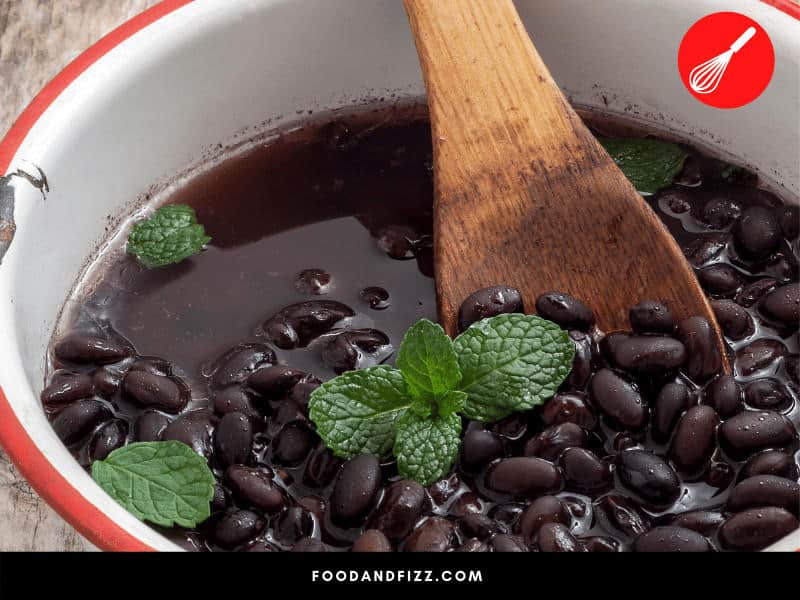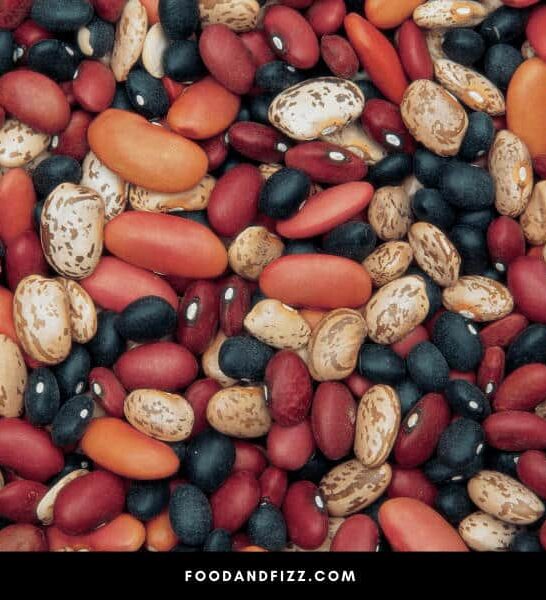You know the old joke about ‘Waiter there’s a fly in my soup’? Well, at least it wasn’t a worm in your beans. Or was it?
Parts of beans look remarkably like worms when cooked, so make sure you know what you are eating when you tuck into a dish of bacon and beans.
Worms in Beans – What Are They? Are The Beans Safe to Eat?
The worms you may find in beans bought from the store are not actually worms, but the larval stage of the lifecycle of common pantry pests. The eggs are laid on or near the beans. When they hatch, the larvae tunnel into the beans and feed off them. They form pupas in the beans and only emerge again as adults. If the beans are cooked properly, it is safe to eat the worms or larvae.

Worms in Beans
The worms that are found in beans are the larvae of weevils or moths that get into the beans to feed and to lay their eggs. The larva and pupa stages of the life cycle of these pests take place inside the bean.
The weevils or moths get into the beans’ container and lay their eggs. When the larvae hatch, they eat the inside of the beans, then make their pupas in the beans and only emerge as adults.
You may buy some beans that have already been contaminated by weevils or moths: they may have laid their eggs in the beans before the packaging process. This means you may very well buy beans into which the worms will hatch.
Bean Weevil
Bean weevils are tiny insects that are often found in beans. The adult weevils are about 0.15 inches (4 mm). You will see them only as small (possibly moving) specks in amongst the beans.
The bean weevil lays its eggs on the beans. When they hatch, the larvae burrow into the bean and only emerge as adults.
Unless you split the beans, you are unlikely to see the worms. If you do see some weevils in the beans, then look out for worms when you cook them.

Cowpea Curculio
The cowpea curculio is similar to the bean weevil. However, it is not only the larvae that eat the beans, but the adults too.
The worms you may find in beans are mostly grubs, which are the larva stage of the life cycle of the curculio. They are pale yellow and have no legs. There may be evidence of the cowpea curculio on the beans in the shape of brown raised spots on the beans.
Pantry Moth Larvae
One of the most common pests in the pantry cupboard is the tiny little moth called the pantry moth. They lay their eggs on the beans. When the larvae hatch, they eat into the beans and feed off them.
The pantry moth larvae are most likely to get into open products, including before packaging. This means they can be brought into the house in bags of beans from the store. The moths can also get into closed packages.
In fact, if the eggs are laid on the outside of packages, larvae can chew through plastic or even thin cardboard to get to the source of food.
Controlling the Worms in the Beans
If you don’t want to find worms in your beans, the key is to prevent them from getting in in the first place. This means keeping the source of the problem out of the packages and out of the pantry.
Bean Weevils
The problem with bean weevils is that they spread and breed quickly. This is why you should try to get rid of any weevils if you see them, or any evidence of them.
Open the packets or boxes and empty the beans into a glass or plastic container that can close up and be air-tight.

There may already be weevil eggs in the beans. If you use the beans quite soon after purchasing them, you may eat some evidence of eggs that have been destroyed by the cooking. You will certainly not find any worms in your beans.
If you are going to store the beans for a while before using them, check them regularly to make sure there is no evidence of pests. If you see any, to avoid having worms in your beans, you can discard the stock.
However, you could also rinse them in water and let the weevils and worms rise to the surface. Dry out the beans and use them soon after.
Pantry Moths
The way to get rid of the worms in your beans is to prevent them getting into them in the first place. This means looking for any signs of the moths. If you see any, you can get rid of the products before they make their way into your pantry.
If you find worms in any beans you open and cook, you can either decide to cook them anyway, or to throw them away. You will definitely need to treat the pantry to get rid of the moths and every stage of their life cycle if possible.
This means inspecting the pantry, including the packaging of dried products, including beans. Throw out any bags that are infested.
Eating Worms in the Beans
The larvae of bean weevils, cowpea curculio and pantry moths will not harm a human digestive system. This means that it is no problem if you eat them.
However, you must make sure that the beans are cooked properly, which means cooking them at a high temperature until they are soft and ready to eat.

Then, there are parts of beans that may look like worms when they are cooked. The bean embryo is the first one. It is a short, elongated part inside the bean, which you will find if you split the bean, or if it splits during cooking. The embryo looks like a small, white worm.
Then there is the skin of the bean. During cooking, it expands and comes away from the bean. The loose skins become shrivelled and can look like worms.
Of course, worms also look like worms in cooked beans. It’s difficult to tell them apart from the parts of the beans themselves.
The long and the short of it is, if the beans are cooked completely and properly, it will do you no harm to eat the worms. If they are in the dish in the first place, of course.
Conclusion to Worms in Beans – What Are They? Are the Beans Safe to Eat?
So, it comes down to cooking your beans thoroughly. This will kill the worms (larvae) and leave them safe to eat.
Of course, if you want to avoid this completely, then either get rid of infested beans, or make sure the pests don’t get into the beans in the first place.

Frequently Asked Questions Worms in Beans – What Are They? Are the Beans Safe to Eat?
How Do I Know If There Are Worms In My Beans?
You can look for holes in the beans. The bean weevil larvae make perfectly round holes to get into the bean to feed.
Can I Eat Beans With Worms in Them?
The worms in beans are mostly larvae from weevils or moths and are safe to eat if the beans are cooked properly.

